The 20th Century began on January 1, 1901 and ended on December 31, 2000.
1900s[]

The HMS Dreadnought.
The 1900s lasted from January 1, 1901 to December 31, 1910. In Great Britain in 1901, Queen Victoria's long-lasting reign would finally come to an end. The Queen, nicknamed "the Grandmother of Europe" because of her relation to the royal families across Europe, ruled Britain when it was marked by great expansion and industrial, cultural, political, scientific, and military progress. Her death marked an end to Britain's greatest era.
In 1903, Virginian brothers Wilbur and Orville Wright shocked the world by building the first successful airplane. The airplane, the Flyer, was flown at Kitty Hawk, North Carolina. Virginia immediately became interested in the airplane, and established the Virginian Air Force. The force consisted of planes and balloons. Europe soon gained an interest in the airplane as well. Several air forces were established across the continent, including the German Luftstreitkrafte.

New Beijing after the earthquake.
For the first half of the 1900s the Chinese city of New Beijing on the western coast of North Brendania was an exciting place to be. The port city, originally a small settlement, grew after gold was discovered all across the coast. The city became home to many gold seekers, as well as many immigrants. Ships from all across the world came to the port, and goods were exported and imported. Then, in 1906, disaster struck. An earthquake struck the city, and the shaking was felt as far north as the colonial border with Russia. The earthquake caused a fire, burning much of the city. An estimated 3000 people died and 80% of the city was destroyed. The local population, however, rebuilt quickly. The disaster resulted in trade, industry and population leaving New Beijing for other cities along the coast.
Throughout the decade a naval and arms race existed between the World Powers and the World Entente. In 1906, Great Britain launched the HMS Dreadnought, which gave it a small advantage over the competing Germany navy. Great Britain had the best navy in the world, followed by Scandinavia, Virginia, and Polynesia. Japan and China, both competing for dominance in Manchuria and Korea, tried to outdo each other with better weapons and ships. By the end of the decade neither side could gain and advantage over the other.
In 1904, the Serbia War occurred. In May 1903, Serbian King Alexander and his wife were nearly assassinated by a group of army officers led by Captain Dragutin Dimitrijevic Apis. After the coup d'etat failed, a civil war began those supporting Alexander and those supporting Apis. This brought great tension to Europe as Alexander was allied with the Austria-Hungary Empire and Apis was allied with Russia and France. In August 1904, the war still continuing, Austria-Hungary invaded Serbia. Apis and his supporters were defeated, but the empire decided to annex Serbia. Tensions in the Balkans were as high as ever. Russia, however, backed down and allowed Serbia to be annexed.
Many technological advances came during this decade, allowing life to be easier. In 1900, the Brownie camera and the battery were invented. In 1901, the typewriter is invented and the phonograph gains popularity. In 1902 air conditioning and the neon lamp were invented. One of the biggest inventions was the Ford Model A, the first car produced by Ford Motor Company.
1910s[]
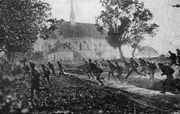
Russian soldiers advancing towards Harbin, China in World War I.
The 1910s saw the bloodiest war in history so far break out: World War I. Trench lines ran across the continents, and barbed wire and machine guns killed the opposition. World War I saw many modern weapons make their debut, such as the tank, machine gun, barbed wire, and the airplane. Fighting existed on every continent besides Antarctica. The war finally ended in 1918 with the surrender of the World Entente to the World Powers. The fighting killed about 20,000 people, and stretches of land were destroyed and famines ruled many parts of the globes.
In 1916, the Russia faced massive upheaval. Emperor Nicholas II and the royal family were assassinated, and civil war began between Communists and Anti-Communists. German, Austrian, and Scandinavian forces took over large parts of land in Russia. A famine ravaged the population, resulting in a total of over two million casualties.

Map of Europe after World War I.
Several disasters occurred across the world throughout the decade. Most notable was the sinking of the ocean line HMS Titanic. The British line, one of the largest in the world, struck and iceberg on its way to Virginia and sunk. Over 1500 people were killed, and the vessel was on its maiden voyage. After the war another disaster came, a disease known as Spanish Flu. The flu killed 20 to 100 million people across the world, and a number had caught it, most notably the Spanish king. During the war the Netherlands is hit by a North Sea storm and it is flooded. The neutral country lost 10,000 lives.
The end of the Great War brought an end to four empires: the Russian, the French, the Welsh, and the British. Russia would transformed into a communist state ruled by Vladimir Lenin. France would lose many parts of its eastern territories. Britain's monarchy would be disestablished and England and Scotland would separate nations, both republics. Wales would lose the Isle of Mann to the Celtic Union. Virginia was another defeated nation. Its main industrial center, Pittsburgh, would become an independent territory.
1920s[]

Benito Mussolini, dictator of the Republic of Rome.
The decade of the 1920s would become known as the Roaring Twenties or the Jazz Age because of the economic boom that followed the end of the Great War. The economy of many nations was strong and prosperous. Not all nations could enjoy this prosperity, though. Defeated nations such as France had much of their land torn apart by the fighting, and the debts caused by the war and the Treaty of Berlin didn't help the situation either.
Many political changes occurred throughout the decade. In Russia, communists under the command of Vladimir Lenin took control of the once great empire. Lenin would die in 1924 and would be succeeded by Leon Trotsky. The Mongolian region of China would nearly come under the control of communists, but China finally put down the rebellion.
Greece would be the site of a horrible civil war from 1917-1928. During World War I, Greece was split over the entry of the entry into the war, and in 1917 southerners led by Eleftherios Venizelos proclaimed independence as the nation of South Greece and supported the World Entente. King Constantine I kept the country neutral but supported the Powers. Civil war began. During the war many other sides would fight, including communist and Ottoman guerrillas.
During the early 1920s, much of the world had a Red Scare, the fear socialist revolutions. For a few years after World War I many of the defeated nations would nearly become communist. France, Russia, Mongolia, and Greece are just a few. In order to prevent the spread of communism, the far-right and fascism would rise. In Virginia, many far right organizations would become popular, including the Ku Klux Klan. In the Republic of Rome, Benito Mussolini of the National Fascist Party would become Prime Minister, establishing the world's first fascist government.
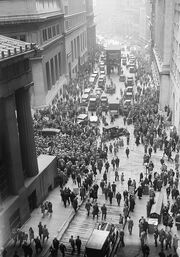
A crowd gathers in Oslo after the 1929 crash.
Many cultural and technological advances occurred during the decade. Jazz music would become widely popular. In film, transition from silent to sound would occur. Famous films would premier, such as The Northern Front, a movie about the Battle of Kensington. The women's suffrage movement makes gains as women gain full voting rights in Scandinavia in 1922, and in Germany in 1927. Manfred von Richthofen, a German pilot, would become the first person to fly solo across the Atlantic Ocean, flying non-stop from Hamburg, Germany to Clonfert, New Clonfert. Radios, automobiles, aviation, telephones, and the power grid would be used.
The economic boom occurring the Roaring Twenties would come to an end on October 29, 1929. The stock market would crash, beginning the worldwide Great Depression.
1930s[]

Dust Fighters during a battle with Spanish soldiers in 1934.
The 1930s, the fourth decade of the 20th century, began on January 1, 1930 and ended on December 31, 1939. The decade is also known as the Crashing Thirties. The economic downfall known as the Great Depression led to authoritarian regimes emerging in several nations, including Philippe Petain in France. Weaker states would be subjugated by their stronger expansionist neighbours, and this ultimately led to World War II by the decade's end.
In 1930 Spanish colonies in North Brendania would suffer from a period of severe dust storms known as the Dust Bowl. The storms would cause agricultural damage to the colonies and farmers would be forced to leave their homes for the coast, where the economic conditions were little better than those they had left. The colonists begged Spain to do something, but Spain had its own problems. This led to the Dust Rebellions, which were led by General Francisco Franco. The rebels were nicknamed Dust Fighters.
Philippe Petain would come to power in France in 1931. The national socialist was unpopular in the past elections for president in France, but the Great Depression greatly helped his cause, and defeated incumbent president Gaston Doumergue. Petain would become dictator of France and transform the nation into an authoritarian state.
The Dust Rebellions would continue for some time. In early 1936, France and its allies recognized the Dust Fighter's cause and declared their support for them. In late 1936, generals in Spain who sided with the rebels attempted a coup d'etat against Spain's government. This would lead to the Spanish War. With the military taking sides, the Dust Fighters would win and established the Republic of Philipia. In Spain, the rebels, along with French volunteers, would win in early 1939. France used the war to test out new weapons and methods of warfare. Francisco Franco would take control of Spain, and united it with the Republic of Philipia to form the Spanish Empire.

Virginian president Albert Ritchie.
In Virginia, democrat Albert Ritchie won the 1932 presidential election. Ritchie, the former governor of Maryland, dealt with the economic situation by constructing new highways and bridges and improving the railroads. This created new jobs which unemployed people became employed in. With Pittsburgh gone, Ritchie began to industrialize areas in the south. Ritchie also introduced his New Deal, which provided relief, recovery, and reform. Ritchie was widely popular, but he refused to run for a second term due to his health. In 1936, democrat Sam Rayburn would be elected president, and continued Ritchie's New Deal.
Across the Atlantic, France and Italy would pursue an aggressive expansionist agenda. In 1934, Italian forces invaded the South Greek island of Corfu, killing 15 civilians. When Greece demanded the island back, Italy refused and continued to occupy it. Corfu was significant because of its strategic location near the entrance of the Adriatic Sea. In 1936, Italian forces invaded eastern Africa, and made it the colony of Italian East Africa. In 1937 France would invade the Balearic Islands during the Spanish War.
In 1939, France and Italy signed the Rome-Paris Alliance, and a year later they signed an alliance with the Japan to form the United Alliance. Wales and Great Britain would join the alliance as well. With France eyeing the Brittany province of Normandy, Germany, Scandinavia, and the Celtic Union announced that an attack on Normandy would lead to a declaration of war on France. At last in September, the storm was breaking. Philippe Petain ordered the attack on Normandy, while Italy would simultaneously attack southern Germany. The attacks began and were quick and catastrophic. The world had been plunged into World War II.
1940s[]

German soldiers in Alsace-Lorraine.
The 1940s was a decade that started on January 1, 1940 and ended on December 31, 1949. Because of World War II, the decade would be known as the War-Torn Forties. World War II took place from 1939 to 1947, and about 85 million people were killed during the war. On one side was the United Alliance, and on the other side was the Central Powers. The Alliance was led by France, Italy, Japan, and the Powers were led by Scandinavia, Germany, and Virginia. The fighting would occur all across the globe.
In continental western Europe, the fighting occurred between France against the forces of Normandy and Germany. After initial territorial gains made by France, the fight evolved into a stalemate, broke in 1945 with German forces breaking past the Rhine in French lines. The Germans pushed deeper into French lines, and the Great Counterattack occurred. Desperate French soldiers pushed the Germans back to border. However, France's luck ran out when Germany and Normandy made it to the capital and conquered it. Petain's government fled to Montpelier, where they continued to direct their soldiers from.
The Eastern Front occurred in Eastern Europe between Scandinavia and Germany against Russia. Russia, at the beginning of the war, and invaded and occupied the Confederacy of the Baltic. Scandinavian soldiers still held in the southern part of the country, which was where Scandinavia counter attacked. Russia, along with the Ottoman Empire, invaded the Balkans. The Ottomans conquered much land before being betrayed by Russia and invaded. The Ottomans then joined the Central Powers. By the beginning of 1947, Central Power forces took Moscow, and Russia surrendered.

Map of alliances in World War II. Blue is Central Powers, Red is United Alliance, and Green is neutral.
The Asian Front was fought between Japan and Russia against China and Polynesia. The Front saw initial invasions by Japan across the Pacific, and a joint Russian-Chinese invasion of Manchuria. After years of bloody warfare, the Chinese and Polynesians pushed the Japanese and Russians from their homelands. In North Brendania, Spain invaded Virginia. After Spanish defeats at Atlanta and Baltimore, the Virginians pushed the Spanish back. In 1945, Philipia was conquered. In South Brendania, the war was fought between Polynesia and Normandy against Phoenicia and the South Brendanian Republic. The war saw many bloody battles, but technology there was not as advanced as in other areas of the world because most of the nations there were newly independent or colonies.
The war was ended with Germany dropping two atomic bombs. The first one was dropped on the French city of Montpelier. Montpelier was where the government located after the loss of Paris. After several refusals to surrender, the Germans dropped the bomb. Petain, Charles de Gaulle, and other government and military members would be part 120,000 killed in the bombing. France surrendered. Three days later, the second atomic bombing was lost in the capital of British South Africa, Cape Town. The British then surrendered, ending World War II.
1950s[]
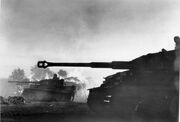
Ottoman tanks in North Greece during the Greek War.
The 1950s opened with the Greek War, a war over foreign interests in Greece. After Greece was split into two nations, North Greece was pro-Ottoman Empire and South Greece was pro-Virginia. War eventually erupted between the two nations. In order to keep their interests in the region, the Ottoman Empire and Virginia both supported their allies. The fighting eventually became a stalemate, and a peace treaty was signed in 1954, permanently divided the former nation.
The Cold War began in the 1950s, between Virginia and its allies against China and its allies. Following the German atomic bombing, both sides attempted to get the nuclear weapon in what was known as the "Race for the Bomb". Virginia would prevail over China in 1959, when it, along with other European allies, tested the bomb in an island in the Arctic Circle. China would get its first atomic bomb in 1964. Both sides were also tasked with rebuilding the newly conquered land. Virginia would begin the "Second Reconstruction" in Philipia, while China continue to industrialize Manchuria even more.

Virginian tanks in Philipia.
Virginia and China would form alliances with other nations, and these alliances turned into organizations. Virginia was the first, and established the New York Pact. The Pact's members were Virginia, Alaska, Portugal, Spain, South Vietnam, South Greece, and Morocco. As a result, China established the Shanghai Cooperation Organization. The SCO's members were China, Siberia, North Vietnam, Japan, and Polynesia. In Europe, the European Treaty Organization was established. Its members were Scandinavia, Germany, Normandy, Italy, France, Austria, Hungary, and Yugoslavia.
In Philipia, violence broke out in what would become known as Castro's Rebellion. The rebellion, led by Fidel Castro, abruptly halted the Second Reconstruction in Philipia. Spaniards all across the new lands rose up in rebellion, and President Omar Bradley ordered the military to enter Philipia. Violence was widespread, and Virginia could not end the rebellion. The casualties continued to mount, and Castro continued to avoid assassination attempts.
1960s[]
The 1960s was decade that started on January 1, 1960 and ended on December 31, 1969. Many call the 1960s a "cultural decade" due to the counterculture and social revolution occurring during the decade across the globe.

Martin Luther King Jr, a leader in the Civil Rights Movement.
In Virginia, the civil rights movement gained attention. Martin Luther King Jr. led the civil rights movement for African-Virginians until his tragic assassination in 1969 at Atlanta, Georgia. Following the 1961 Washington Riot, I. M. Pei led the civil rights movement for the Chinese. Pei was met with much opposition, but his movement was successful and influenced the Civil Rights Act of 1964 and the Civil Rights Act of 1968. Gustabo Diaz Ordaz led by the civil rights movement for the Spaniards. The Spanish had been the target of racism since World War II and Castro's Rebellion, but Ordaz's movement succeeded as well.
The 1960s also featured a war-like atmosphere because of two major wars occurring at the time. The first war was Castro's Rebellion. The war started in 1956 and by 1960 was in its 4th year by 1960. In 1962 Castro was finally assassinated, but this could not save Omar Bradley's presidency. Democrat Lyndon B. Johnson defeated him in the 1962 election, and in 1964 Castro's forces were finally defeated.
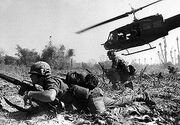
Virginian soldiers in Vietnam.
The second war was the Vietnam War. While a small number of Virginian troops were stationed in South Vietnam, the war was considered a slideshow to the Rebellion. When the Rebellion finally ended, Johnson turned his attention to Vietnam. Troop numbers there were doubled and tripled for the next few years, which greatly aided the South Vietnamese. Deadly battles were fought at Khe Sahn, Hue and Saigon. With Johnson's re-election in 1966, he continued to focus on Vietnam. By 1969 the boundaries were restored to pre-war.
The Nepal Missile Crisis also arose during the decade. With the Vietnam War in full swing, the Chinese decided to place their nuclear weapons in the Yucatan Peninsula, which could easily target Washington and Virginia. In response to this, Virginia placed nuclear weaponry in Nepal, one of their allies. The Chinese did not accept this, and supported a short rebellion to overthrow the pro-Virginian dictator. The rebellion failed, and China debated over invading Nepal and risk war with Virginia. Eventually, it was decided that Virginia would remove their weapons from Nepal in exchange for China removing their nuclear weapons from Yucatan.
Near the end of the decade two major wars broke out. The first war was known as The Troubles. Welsh patriots in Celtic-occupied Great Britain rose up in rebellion, and several bombings occurred in major Welsh cities such as Swansea and Cardiff. In order to keep the rebellion from spilling into from the rest of Great Britain, the Celtic Union increased the amount of soldiers it had in Wales. Wales became separated from the rest of the island, with military units at checkpoints on the border with England, preventing most people from coming in or out of the region in rebellion.
The second war was the Afghanistan War. Following their successful campaign in Iran in 1956 which led to the addition of Iran to the Empire, the Ottomans looked to expand more into Central Asia. The Empire targeted Afghanistan, which it thought could be a springboard into the nations of Pakistan and India. In 1968, a coup overthrew the Afghan leader, establishing a pro-Ottoman dictatorship. However, rebellions broke out, which were led by the Mujahideen. In 1969, several areas in Afghanistan were taken by the rebels. In order to keep Afghanistan as an ally, the Ottoman Empire intervened and invaded the western portion of country during that same year.
1970s[]
The 1970s was a decade that began on January 1, 1970 and ended on December 31, 1979. The 1970s was rocked with multiple wars which had worldwide consequences.
The industrialized nations of the world experienced an economic recession caused by the Oil Crisis. When in 1974 it was proven by the Ottoman Empire that Virginia was aiding the rebels in Afghanistan, the Empire and its allies placed an embargo on oil. This affected Virginia and its allies, whose main supplier of oil was in the Middle East. Oil prices shot up in Virginia, who also faced an oil shortage. Virginia entered an economic slump, with other events also causing this.

Ottoman soldiers in Afghanistan.
Meanwhile, the Ottoman Empire was not faring well in its campaign in Afghanistan. Following quick victories in the beginning of the war, resistance was much fiercer. The farthest the Ottomans would get would be Kabul, where they would be defeated by resistance by Iraqi rebel Saddam Hussein. Hussein would become well known for his brilliant tactics against the Empire, and would become leader of the resistance. The Ottomans tried to stop the rebels by having reprisals against the Afghan people. This only created more support for the resistance. In 1974, the Ottomans launched a desperate final attack. Several defeats, however, forced them back. The Ottomans left in 1979, and Afghanistan was free from Ottoman rule. Iraq and Iran also broke away from the Ottoman Empire's rule.
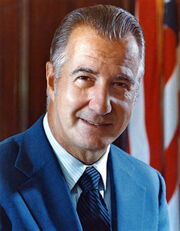
Virginian President Spiro Agnew.
War also broke out in the continent of Africa. Battleground Africa, as it was called, was the defining moment for the African Union. The war began with the overthrow of the Ethiopian ruler with a Chinese-backed one, and war began between the nations of the Horn. The African Union attempted to stop the crisis, but could not and war began to spread to the other regions of Africa. In southern Africa, the local British population rose up in rebellion, giving the war another front. When it became clear that the African Union could not handle the situation, Virginian President Spiro Agnew stationed Virginia's military in several countries. After Morocco attacked Virginian-occupied Spain, Agnew began launching attacks across Africa. However, Agnew made a botched job of it, and the economy continued to spiral down.
With the wars and the economic recession, environmentalism and feminism began to gain movement. With oil not coming to Virginia, several fuel efficient cars were created and many people tried to use less oil. The wars also destroyed lots of the environment, and environmentalists tried to protect species of the wild such as the rare ones in Africa. Feminism was also on the rise, and several women became leaders of countries, such as in the Celtic Union. With all this riding, Chester Wilkins defeated Spiro Agnew in the 1978 Virginian Presidential election, and many people saw this as the beginning of something.
1980s[]
The 1980s was a decade that began on January 1, 1980 and ended on December 31, 1989. During the first two years of Chester Wilkins he increased troop numbers in Battleground Africa, and in 1980, America launched operation Desert Storm, the liberation of nations around the Sahara Desert. Wilkins also brought back the economy with what was known as "Wilkinomics".
In the Eastern Hemisphere, China faced problems with Japan, a nation it occupied since the end of World War II and was an unofficial "territory" of China. Population boomed in Japan in the late 1970s, and the economic recession caused many problems in Japan. Workplaces in Japan were owned by Chinese, and Japanese were prevented from applying for a job. Many families that could not work lived in slums near large cities such as Tokyo. Finally this issue came to a head in 1983, where a group of Japanese people protested in Tokyo. China responded with live fire from tanks and soldiers, and a crackdown began on supporters of the protests. The Japanese responded with riots across the city, and waves of killing began between the Japanese and Chinese. Finally, in 1989, China granted Japan independence. However, China forced all ethnic Japanese from the country to Japan, and began a blockade of the islands, hoping Japan would eventually submit. Virginian President Al Gore, began to send supplies to Japan by air. Finally, at the end of 1989, China ended it blockade.
